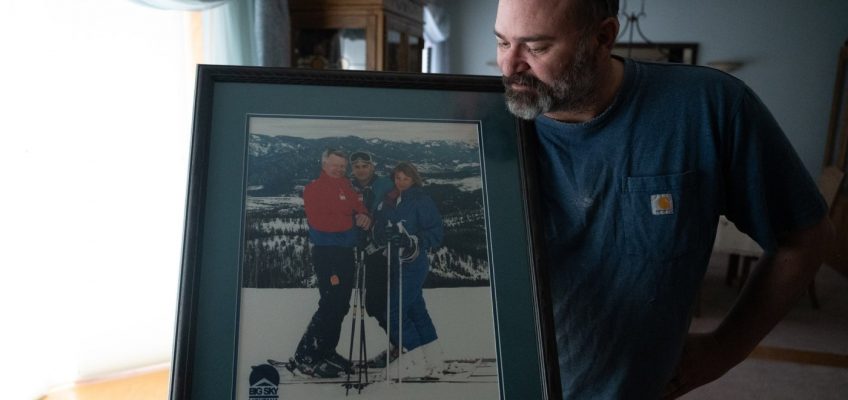Jordan Rau | (TNS) KFF Health News
Dan Shively had been a bank president who built floats for July Fourth parades in Cody, Wyoming, and adored fly-fishing with his sons. Jeffrey Dowd had been an auto mechanic who ran a dog rescue and hosted a Sunday blues radio show in Santa Fe.
By the time their lives intersected at Canyon Creek Memory Care Community in Billings, Montana, both were deep in the grips of dementia and exhibiting some of the disease’s terrible traits.
Shively had been wandering lost in his neighborhood, having outbursts at home, and leaving the gas stove on. Dowd previously had been hospitalized for being confused, suicidal, and agitated, medical records filed in U.S. District Court in Billings show. When Dowd entered Canyon Creek, managers warned employees in a note later filed in court that he could be “physically/verbally abusive when frustrated.”
On Shively’s fourth day at Canyon Creek, carrying a knife and fork, he walked over to a dining room table where Dowd was sitting. Dowd told Shively to keep the knife away from his coffee, according to a witness statement filed in court. Shively, who at 5-foot-2 and 125 pounds was half Dowd’s weight and 10 inches shorter, turned to walk away, but Dowd stood up and shoved Shively so hard that when he hit the floor, his skull fractured and brain hemorrhaged, according to a lawsuit his family filed against Canyon Creek.
“The doctor said there’s not much they could do about it,” his son Casey Shively said in an interview.
Dan Shively died five days later at age 73.
Police did not charge Dowd, then 66. He stayed at Canyon Creek for nearly three more years, during which time he repeatedly clashed with residents, sometimes hitting male residents and groping female ones, according to facility records filed in the court case. His anger would flare quickly. “I’m literally scared to death of Jeff,” one nurse wrote in a filed statement describing Dowd’s dispute with another resident.
In court, Canyon Creek denied liability for Shively’s death. Its privately held corporate owner, Koelsch Communities, declined to answer questions from KFF Health News. Chase Salyers, Koelsch’s director of marketing, said in an email to KFF Health News that the company prioritizes “the health, well-being, safety, and security of our residents.”
Dowd’s relatives said in a statement via text they would not comment because they had no firsthand knowledge. “We were very pleased with the care Jeffrey received at Canyon Creek,” they added. Dowd was not named in the lawsuit and his current whereabouts could not be determined.
Violent altercations between residents in long-term care facilities are alarmingly common. Across the country, residents in nursing homes or assisted living centers have been killed by other residents who weaponized a bedrail, shoved pillow stuffing into a person’s mouth, or removed an oxygen mask.
A recent study in JAMA Network Open of 14 New York assisted living homes found that, within one month, 15% of residents experienced verbal, physical, or sexual resident-on-resident aggression. Another study found nearly 8% of assisted living residents engaged in physical aggression or abuse toward residents or staff members within one month. Dementia residents are especially likely to be involved in altercations because the disease damages the parts of the brain affecting memory, language, reasoning, and social behavior.
More than 900,000 people with Alzheimer’s or other types of dementia reside in nursing homes and assisted living centers. Many of the most seriously impaired live in the roughly 5,000 facilities with locked dementia floors or wings or the 3,300 homes devoted exclusively to memory care. These places are mostly for-profit and often charge thousands of dollars extra a month, promising expertise in the disease and a safe environment.
Clashes can be spontaneous and too unpredictable to prevent. But the chance of an altercation increases when memory care homes admit and retain residents they can’t manage, according to a KFF Health News examination of inspection and court records and interviews with researchers. Homes that have too few staffers or nonexistent or perfunctory training for employees have a harder time heading off resident conflicts. Homes also may fail to properly assess incoming residents or may keep them despite demonstrated threats to others.
“As much as long-term care providers in general do their best to provide competent, high-quality care, there is a real problem with endemic violence,” said Karl Pillemer, a gerontologist at Cornell University and lead author of the JAMA study.
“There needs to be much more of an effort to single out verbal and physical aggression that occurs in long-term care,” he said, “and begin to create a model of violence-free zones in the same way we have violence-free zones in the schools.”
A Danger to Others
The first signs of Shively’s vascular dementia emerged in 2011 as confusion, but the disease accelerated in 2016, according to interviews with his wife and children and his medical records. He began referring to mountains he knew well by the wrong name and forgot how to tie flies on his fishing line. “The decline was so slow at first we thought we could manage,” his wife, Tana Shively, said in an interview before her death this year.
As the disease progressed, his outbursts became hard to handle. He took a swing at one of his sons when upset about the temperature in the house. He refused to swallow his medications and fell repeatedly.
“He would start walking the neighborhood and get lost,” Casey said. “He would turn on the gas stove but not light the stove, and the room would start filling up with gas. He would put clothing in strange places. I found socks in a punch bowl. It got to the point where we couldn’t do this anymore.”
Dowd, meanwhile, had lived in a Santa Fe nursing home and had a long history of dementia with behavioral issues, major depressive disorder with psychotic features, and hypertension, according to medical records filed in court. Dowd entered Canyon Creek in October 2018 to be closer to his brother, who lived nearby in Wyoming, according to an admission notice the facility provided to employees that was included in the court record. The notice said Dowd suffered from dementia caused by excessive and long-term alcohol use.
Two months later, Shively moved in.
Canyon Creek Memory Care Community in Billings, Montana, where Dan Shively died, is licensed as a Level C assisted living facility. Level C facilities are permitted to house people with cognitive impairments so severe that they cannot express their needs or make basic care decisions. (Jessica Plance for KFF Health News/TNS)
Montana licenses Canyon Creek, which has 67 beds, as a Level C assisted living facility, which permits it to house people with cognitive impairments so severe that they cannot express their needs or make basic care decisions. Montana law says these facilities cannot admit or retain a resident who is “a danger to self or others.”
In the lawsuit, Shively’s family argued that, given that law, Canyon Creek never should have accepted or kept Dowd. The Shively family’s lawyer, Torger Oaas, noted in court papers that Canyon Creek’s intake assessment form for Dowd categorized his behavior as “physically and/or verbally abusive/aggressive 1x per month.” Oaas also wrote in court papers that in Dowd’s first weeks at Canyon Creek, he mocked and threatened to hit other residents and threw someone’s silverware to the ground during dinner.
In its defense filings in the lawsuit, Canyon Creek said the Montana statute was too broad to be the basis of a negligence claim and argued that all memory care residents are unpredictable. And while Dowd had yelled and cursed at other residents at Canyon Creek, he hadn’t had physical confrontations — or any conflicts with Shively, Canyon Creek said. “The accident was not reasonably foreseeable,” Canyon Creek argued.
In the days after Shively’s fall, nurses noted that Dowd was “more anxious, angry toward others.” Dowd yelled at a nurse to get off the phone and “do your job,” a nurse wrote in a logbook entry filed in court.
“He got into my face,” the nurse wrote. “It looked like he was going to hit me — he had his hand/fist raised.”
‘As Bad as I’ve Ever Seen It’
People with dementia will lash out because they no longer have social inhibitions or because it’s the only way they can express pain, discomfort, fear, disagreement, or anxiety. Some common triggers — overstimulation from loud noises, a frenzied atmosphere, unfamiliar faces — are hallmarks of dementia care institutions.
“We can’t expect someone who is constantly and unfailingly disoriented to adapt to our environment anymore,” said Tracy Wharton, a licensed clinical social worker and dementia researcher in Florida. “We have to adapt to them.”
Eilon Caspi, a University of Connecticut researcher, analyzed 105 fatal incidents involving dementia residents and found 44% were fatal falls in which one resident pushed another. “Some people are aggressive, and some are violent,” Caspi said, “but if you look closely, the vast majority are doing their best while living with a serious brain disease.”
Holly Harmon, a senior vice president at the American Health Care Association/National Center for Assisted Living, an industry trade group, said in a written statement that conflicts cannot always be averted despite facility operators’ best efforts. “If they do occur,” she said, “providers respond promptly with interventions to protect the residents and staff and prevent future occurrences.”
But Richard Mollot, executive director of the Long Term Care Community Coalition, a resident advocacy group, said many operators of assisted living centers, including memory care units, are driven by the bottom line. “The issue that we see quite often is that assisted living retains people they should not,” Mollot said. “They don’t have the staffing or the competency or the structure to provide safe care.” Conversely, he said, when facilities have enough rooms filled with paying customers, they are more likely to evict residents who require too much attention.
“They will kick them out if they’re too cumbersome,” Mollot said.
Teepa Snow, an occupational therapist who founded Positive Approach to Care, a company that trains dementia caregivers, noted that the space inside many facilities, with double rooms, tight common areas, and restricted outdoor access, can fuel conflicts. She said the pandemic degraded conditions in long-term care, as dementia residents with limited social skills atrophied in isolation in their rooms and staffing grew even sparser.
“It’s as bad as I’ve ever seen it,” she said.
‘Very Common Fits of Rage’
The following account of Dowd’s time at Canyon Creek is based on 44 pages of nurse’s notes, witness statements, and internal resident-on-resident altercation reports; all were contained in the facility’s records and filed as exhibits in the court case. After Shively’s death in December 2018, Dowd was given new prescriptions, although the court record is unclear if the change was because of Shively’s death. Still, the records show, Canyon Creek was unable to head off recurring altercations involving Dowd.
Some were verbal threats. Once, Dowd yelled at residents in the living room to shut up, called them “retards” and told them they should all die, a caregiver wrote in a witness statement. He grabbed one resident’s face and threatened to kill him, according to a nurse’s note. Another time, Dowd went up to a resident sitting on a sofa and grabbed his walker. Dowd shook it and told him to shut up. According to a witness statement, as a nurse took the resident to the bathroom, Dowd muttered under his breath: “Stuff his head in the toilet.”
Other conflicts were physical. Dowd shoved a resident “down on his back so hard his head bounced off the floor,” a nurse recorded in a note. In a different incident reported by a nurse, Dowd pushed a resident who had been agitated and cursing into a chair. On separate occasions, Dowd hit two residents on the head, once causing bleeding, according to two resident altercation reports.
The notes detail that Dowd was not always the initiator. Once, Dowd’s roommate scratched and punched him after Dowd told him to use the toilet rather than pee on the floor, resulting in a fight. Caregivers separated the two. Another day, a resident named Bill wandered into Dowd’s room and pulled Dowd’s hair and beard. Dowd told the nurses he “felt unsafe and VERY angry,” a nurse’s note said. The nurse led Bill out of Dowd’s room, but Dowd followed, yelling at Bill that he was “a fat bastard” and saying he was going to make Bill’s wife a widow.
“Jeff kept making a closed fist as tho he was going to hit Bill,” the nurse wrote in a witness statement. “I was legit scared because there was nothing I could do to defuse the situation. I’m literally scared to death of Jeff. I’m scared to approach him and talk to him when he gets into these very common fits of rage.”
Dowd ultimately went back to his room and a worker locked his door so no other resident would go in.
The records describe how Canyon Creek caregivers intervened after altercations began, often separating the fighting residents and updating Dowd’s brother on the clashes. Nurses would remove Dowd or the other resident from a room and discourage such acts. “Tried to explain it was inappropriate to hurt others,” one nurse wrote after one incident.
Salyers, the company marketing director, said in his email that the workers at Canyon Creek and other Koelsch facilities are “highly qualified” and “extensively trained.” He said the company’s memory care communities are “distinctively designed and staffed” for people with Alzheimer’s and other forms of dementia.
‘It’s Nice To Have a Girlfriend’
The nursing notes and statements in the court file suggest that incidents were frequent enough that nurses commented on Dowd’s occasional serenity. “No agitated or aggressive behaviors this shift,” one note said. Another nurse note said Dowd “continues to isolate at meals, sitting at a table by himself.” While Dowd enjoyed reading books and doing puzzles, he was overheard saying he was depressed and was “wondering if he wouldn’t be better off if he wasn’t around anymore.”
Nurses noted Dowd repeatedly exhibited sexual behavior that was either inappropriate — making “crude oral gestures while looking at younger females” — or ambiguous, such as placing his hand on a resident’s shoulder and commenting, “It’s nice to have a girlfriend.” Someone saw Dowd “grabbing on multiple residents[‘] private areas,” a witness statement said. When nurses caught the behavior, they separated those involved and rebuked Dowd. A staff member wrote in a statement that Dowd was inappropriate throughout her shift, making sexual jokes and “trying to grab me.”
According to nursing notes, in summer 2021, Dowd told one female resident he wanted to see her genitals and later touched her breast. In August, a caregiver walked into Dowd’s room and found him touching the same resident under her shirt and pants. The caregiver told Dowd to “stop it and not ever do that again” and brought the woman out to meet her family, who had come to visit her.
After that incident, Canyon Creek sent Dowd to the emergency room at Montana State Hospital, a public psychiatric facility, according to a nurse administrator’s testimony in a deposition filed in court. The nurse testified Dowd was no longer at Canyon Creek. That is the last mention of Dowd’s whereabouts in the public record. A spokesperson for the Montana Department of Public Health and Human Services, which oversees the hospital, would not confirm whether he was a patient.
At a pretrial hearing, the judge excluded discussion about Dowd’s altercations after Shively’s death. In a court filing, Shively’s lawyer asked permission to share evidence with the jury that Canyon Creek gave its executive director a bonus any month when 90% or more of the beds were filled so he could argue Canyon Creek had a financial motivation to admit Dowd. But the judge also barred that information from the trial, which Canyon Creek said in a court filing was irrelevant.
The Shively case went to trial in 2022 before a federal civil jury in Billings. Despite the exclusions, the jury decided Canyon Creek’s negligence caused Shively’s death. It awarded the family $310,000.
“For us, the money wasn’t a huge factor,” said Spencer Shively, another of Dan Shively’s sons, who called the damages so modest as to be a victory for Canyon Creek or its insurer. “At least they were negligent per se. But I don’t know it really changed anything. For me, I got some closure. I feel like these facilities are just continuing to do the same things they’re going to do because there hasn’t been systemic change.”
___
(KFF Health News is a national newsroom that produces in-depth journalism about health issues and is one of the core operating programs of KFF — the independent source for health policy research, polling and journalism.)
©2024 KFF Health News. Distributed by Tribune Content Agency, LLC.




